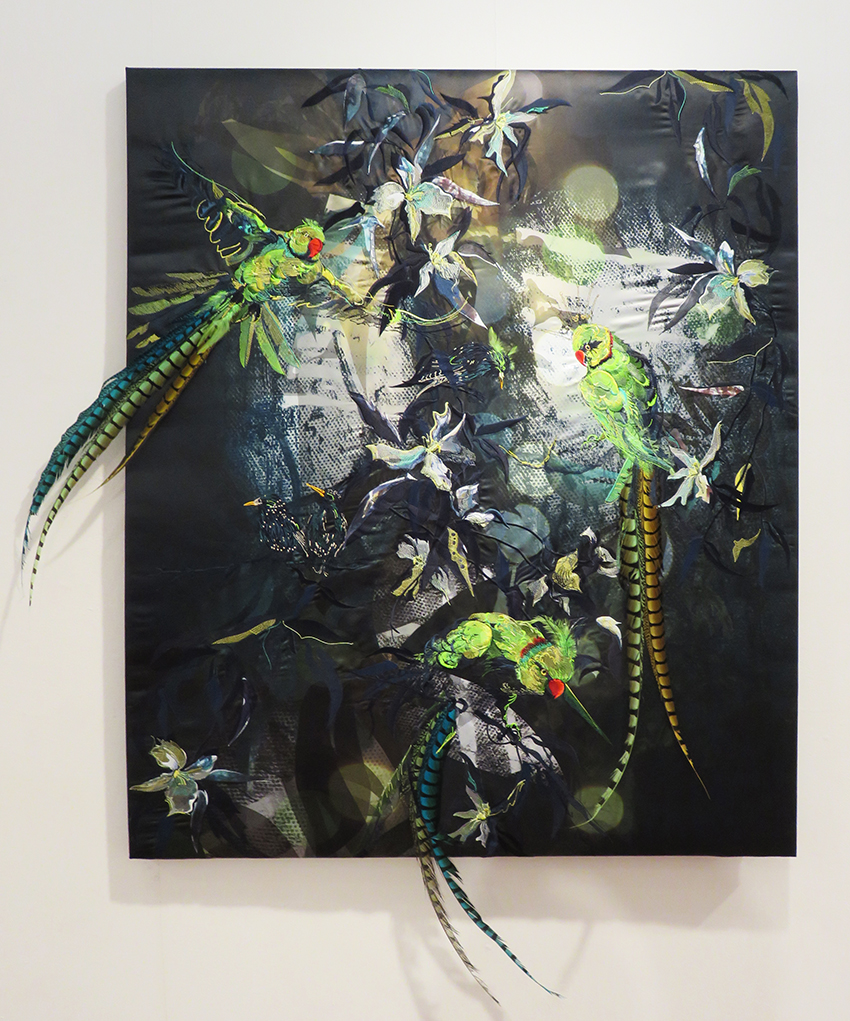
The night before the private view I had a dream that a giant version of the work featured on the poster ( see above) was writhing around the gallery walls and flashing strobe lights, while all the other pieces of work in the exhibition were equally massive and glowing while moving to – for want of a better word – ‘disco’ music: I thought – oh no! my poor flat patchwork!

The featured work by Lynne Machlachan was on display with her other wonderful constructions in blends of strong colours they undulated around the walls and in the air. A panel of photographs showed them being worn, I hesitate to call them jewelry…
On reflection I feel that this work set an atmosphere for the exhibition; clear, strong, flat colour, immaculate attention to surface detail, and a definite sense of playfulness were qualities I enjoyed throughout the rooms. The only strobe effects were caused by overlapping patterns on a smaller scale in many exhibits.

Whether by intention of the makers or sympathetic lighting on the part of the curators, the play of light and shadow were fascinating. I constantly returned to view the works of 2 makers who collaborated to show small woven metal constructions, Jonathan Cleaver and David Poston,


Even when I viewed larger scale works that had became almost installations in the way they were exhibited, the same themes of flat brilliant colour and clean elegant construction were apparent – and the use of this singing yellow and metal together.

colour and pattern throughout the exhibition links very disparate materials and ideas

The machine embroideries of Jacky Puzey echo both colour and form when seen against the metal sculptures. Her large dramatic panel of birds is a real master class in placing together disparate materials and media so that they flow easily one into the another.


The degree of skill on view within the exhibition is made apparent in different ways, certainly to change or add new materials to your original practice makes you concentrate on the “joins” and here nearly every piece of work combined either 2 or more materials or the makers had transferred the techniques of one discipline to another…or they made juxtapositions of natural with man made found objects – never easy.

Ancient bronze thimbles carry coral and sea urchin spines, like tiny offerings to the goddess of stitch! And there were boxes made from a metal shield mount, still with tracings of old patterning mounted with diamonds.
One of the major themes of the exhibition is the transformation of one material to describe another and there were many examples including my own.

One of the advantages of Private Views is to meet up with other exhibitors, I often find that talking to people work who work totally differently to me are always stimulating. I was introduced to Valeria Nascimento and we spent some time together discussing our very different work. as we walked we both stopped and gazed at the work of Anna LorenzIt is intriguing; you just can’t guess the material ( well I am a maker and stimulated by materials) It looks like unglazed porcelain or paper porcelain, or unfired porcelain, or paper or felt or…. or….but it is news print; and it is perforated, but how? Valeria and I were looking behind it, inside its layers and I took this image of the gradated shadow it threw – so much a part of its complete and compelling mystery.
Arriving at Valeria’s work I realised that I had photographed it as soon as I walked into the gallery, drawn to the far wall of what looked like bleached shells and sea creatures.

Her table of porcelain jewelry in stark blacks and whites really intrigued me, the fluffy neck pendants and the massive rings and brooches are not to my personal taste but their presence and implication of natural forms through simple and sympathetic use of her media, just made me want to hold them – and that’s why we go to exhibitions isn’t it – to extend our imaginations and ideas.
 Sea creatures emerged as inspiration in the beaded work of Wanshu Li, translucent and iridescent tentacles of colour made up large rings and bracelets.
Sea creatures emerged as inspiration in the beaded work of Wanshu Li, translucent and iridescent tentacles of colour made up large rings and bracelets.

and accompanying her work were high contrast photographs underlining the quality of deep sea beings… looking at this work made me see a fish in an adjacent vitrine.

Every once in a while you see work that just makes you jealous and wishing that you could have made it – the work of Zoe Hillyard really stopped me in my tracks. First it was beautifully thought-through and formed, second it reminded of work that I had made previously, and third – I wished that I could have used it for an exhibition I co-curated some years ago – Mending at the Museum.

I had actually tried a similar exercise when I was working on ‘mending’ ceramics – but it did not look like this; here are elegant breaks, refined textiles wrapped and stitched to perfection and the soft colouring entirely at one with the materials – it is patch-worked!
I really appreciated this work, especially her dense stitching on the inside of the pieces, used to draw the fabric tight against the curves, she managed to make this as decorative as it was functional. Just so desirable and a perfect transference of materials and ideas – and she made the jars then smashed them herself!!
I cold go on and on about the ideas, images, thoughts and provocations elicited by this exhibition – but now show that finally, after months of work, the Patchwork Enamel was successfully transported and hung and here it is complete with shadows…



















































